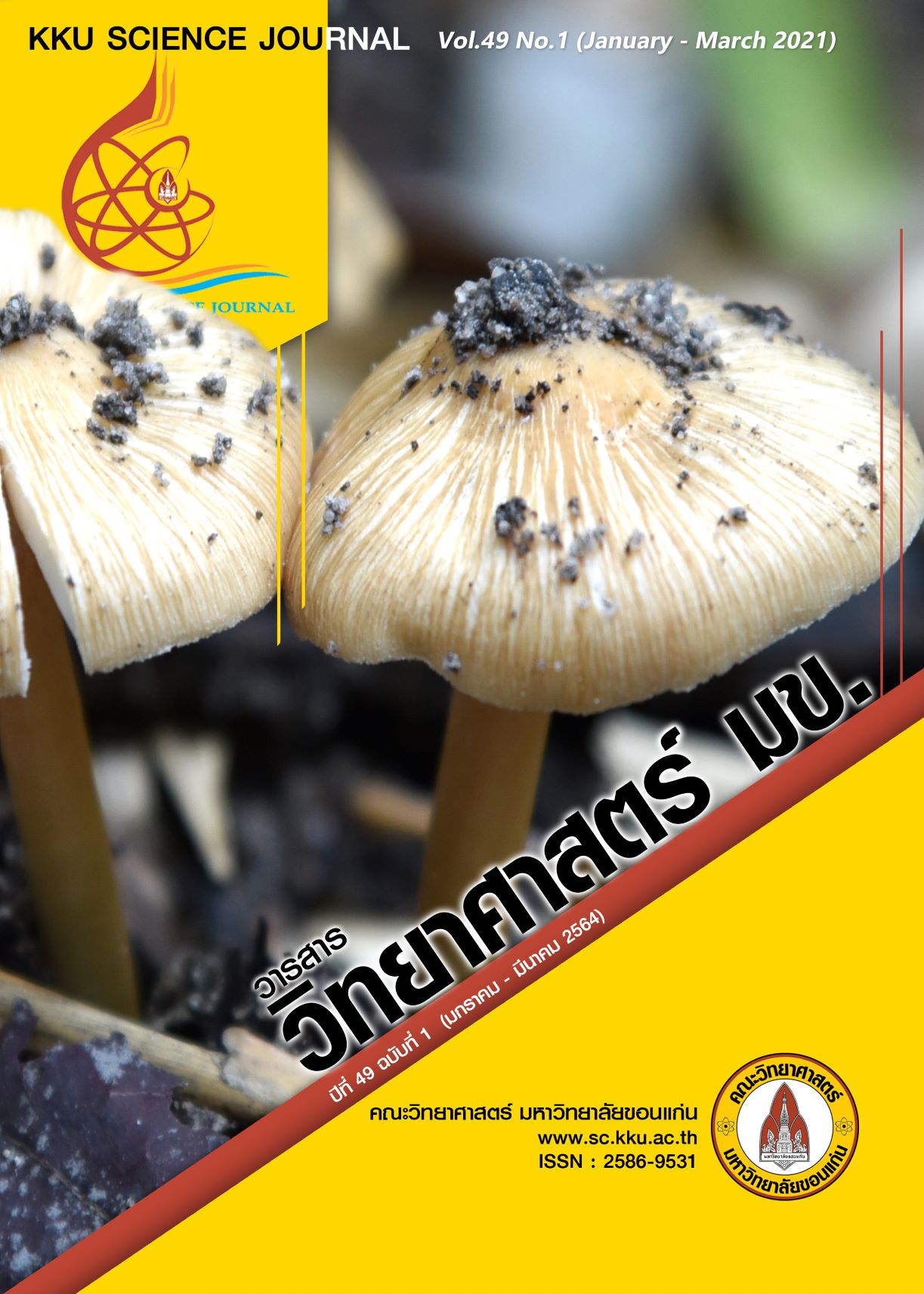การพัฒนาการเตรียมแอนติเจนสำหรับการตรวจไก่ที่มีแอนติบอดีต่อเชื้อ Salmonella Enteritidis ด้วยวิธี Rapid Slide Agglutination
Main Article Content
บทคัดย่อ
การศึกษานี้มีจุดประสงค์เพื่อพัฒนาการเตรียมแอนติเจนของเชื้อ Salmonella Enteritidis (SE) สำหรับการตรวจ rapid slide agglutination (RSA) และเปรียบเทียบการเตรียมแอนติเจนด้วยวิธี formalin inactivation และ วิธี alcohol inactivation ตัวอย่างซีรัมที่ใช้สำหรับการทดสอบแบ่งเป็น 3 กลุ่มได้แก่ กลุ่ม 1 ซีรัมจากไก่สุขภาพดีและปลอดการติดเชื้อซัลโมเนลลาจำนวน 60 ตัวอย่าง กลุ่ม 2 ซีรัมจากไก่ที่ได้รับ killed SE antigen จำนวน 20 ตัวอย่าง และกลุ่ม 3 ซีรัมจากไก่ที่ป้อนเชื้อ SE (106 CFU/ตัว) จำนวน 20 ตัวอย่าง ผลการศึกษาพบว่า เมื่อทดสอบ RSA ด้วยแอนติเจนทั้ง 2 วิธีตัวอย่างซีรัมจากไก่กลุ่ม 1 ให้ผลลบทั้ง 60 ตัวอย่าง (100%) ตัวอย่างจากไก่กลุ่ม 2 ให้ผลบวก 20 ตัวอย่าง (100%) ต่อแอนติเจน SE formalin inactivated และให้ผลบวก 19 ตัวอย่าง (95%) ต่อแอนติเจน SE alcohol inactivated และตัวอย่างซีรัมจากไก่กลุ่ม 3 ให้ผลบวก 19 ตัวอย่าง (95%) ต่อแอนติเจน SE formalin inactivated และให้ผลบวก 16 ตัวอย่าง (80%) ต่อแอนติเจน SE alcohol inactivated เมื่อนำแอนติเจนที่เตรียมทั้ง 2 วิธี มาทดสอบ cross reactivity ต่อเชื้อ S. Typhimurium (ST) โดยใช้ตัวอย่างซีรัมของไก่ที่ให้ killed ST antigen หรือได้รับเชื้อ ST (106 CFU/ตัว) พบว่าผลการตรวจ RSA กับแอนติเจน SE formalin inactivated ให้ผลบวกต่ำกว่า แอนติเจน SE alcohol inactivated อย่างมีนัยสำคัญทางสถิติ (p<0.05) และเมื่อนำ แอนติเจนที่เตรียมทั้ง 2 วิธีไปทดสอบ RSA กับซีรัมที่มาจากฝูงไก่ที่เลี้ยงเพื่อการค้าจำนวน 3 ฝูงพบว่า ผลการตรวจ RSA กับแอนติเจนที่เตรียมทั้ง 2 วิธีนี้สามารถตรวจแยกฝูงไก่ที่สุขภาพดีและฝูงไก่ที่ติดเชื้อ SE ในฝูงได้จากการศึกษาครั้งนี้สรุปได้ว่าผลการทดสอบ RSA กับแอนติเจน formalin inactivated ให้ผลการทดสอบที่ดีกว่าแอนติเจน alcohol inactivated และแอนติเจนที่เตรียมมาจากทั้ง 2 วิธีนี้สามารถนำไปใช้ตรวจซีรัมจากฝูงไก่ที่สงสัยมีการติดเชื้อ SE ในทางปฏิบัติการได้
Article Details

This work is licensed under a Creative Commons Attribution-NonCommercial-NoDerivatives 4.0 International License.
References
ณัฐา จริยภมรกุร วิชัย สุทธิธรรม และดรุณี ศรีชนะ. (2558). การสํารวจแบคทีเรียก่อโรคซึ่งปนเปื้อนในไข่ที่วางจําหน่ายในเขตอําเภอคลองหลวง จังหวัดปทุมธานี. Thai Journal of Science and Technology 4(1): 104-114.
ระเบียบกรมปศุสัตว์ว่าด้วยการควบคุมโรคแซลโมเนลลาสําหรับสัตว์ปีก. (2553, 8 ธันวาคม). ราชกิจจานุเบกษา. เล่ม 127 ตอนพิเศษ 140 ง. หน้า 2.
วรรณา พรรณรักษา สดใส เวชชาชีวะ และดิลก เย็นบุตร. (2521). การศึกษาเบื้องต้นในการหา Salmonella Typhi O antibody โดยวิธี slide agglutination test. จุฬาลงกรณเวชสาร 22 (4): 261-264.
สุมาลี เลี่ยมทอง. (2560). ความชุกของเชื้อ Salmonella ที่แยกจากเนื้อสัตว์ค้าปลีกในอําเภอเมืองจังหวัดนครศรีธรรมราช. วารสารวิชชา 36(1): 72-85
อดิศร ดวงอ่อนนาม คมกริช พิมพ์ภักดี และปิยวัฒน์ สายพันธุ์. (2554). ความชุกและซีโรวาร์ของซัลโมเนลลาในเนื้อโคที่จําหน่ายข้างถนนจากขั้นตอนการตัดแต่งซากในโรงฆ่าสัตว์การขนส่งซากและร้านจําหน่ายในจังหวัดร้อยเอ็ด. ใน: รายงานการประชุมวิชาการเสนอผลงานวิจัยระดับบัณฑิตศึกษาครั้งที่ 12 มหาวิทยาลัยขอนแก่นขอนแก่น. 1105-1115.
Barrow, P. A., Berchieri, A., Jr. and Al-Haddad, O. (1992). Serological response of chickens to infection with Salmonella Gallinarum-S. Pullorum detected by enzyme-linked immunosorbent assay. Avian Diseases 36(2): 227-236.
Barrow, P. A., Bumstead, N., Marston, K., Lovell, M. A. and Wigley, P. (2004). Faecal shedding and intestinal colonization of Salmonella Enterica in in-bred chickens: the effect of host-genetic background. Epidemiology and Infection 132(1): 117-126.
Barrow, P. A., Jones, M. A., Smith, A. L. and Wigley, P. (2012). The long view: Salmonella-the last forty years. Avian Pathology 41(5): 413-420.
Gast, R. K. (1997). Detecting infections of chickens with recent Salmonella Pullorum isolates using standard sero-logical methods. Poultry Science 76(1): 17-23.
Gast, R. K., Guard-Petter, J. and Holt, P. S. (2002). Characteristics of Salmonella Enteritidis contamination in eggs after oral, aerosol, and intravenous inoculation of laying hens. Avian Diseases 46(3): 629-635.
Van Immerseel, F., De Buck, J., Pasmans, F., Bohez, L., Boyen, F., Haesebrouck, F., and Ducatelle, R. (2004). Intermittent long-term shedding and induction of carrier birds after infection of chickens early posthatch with a low or high dose of Salmonella Enteritidis. Poultry Science 83(11): 1911-1916.
Jones, F. S. (1913). The value of the macroscopic agglutination test in detecting fowls that are harboring Bact. Pullorum. Journal of Medical Research 27(4): 481-495.
Kim, C. J., Nagaraja, K. V. and Pomeroy, B. S. (1991). Enzyme-linked immunosorbent assay for the detection of SalmonellaEnteritidis infection in chickens. American Journal of Veterinary Research 52(7): 1069-1074.
Kolmer, J. A., Spaulding, E. H. and Robinson, H. W. (1951). Approved laboratory technic, 5th ed New York: Appleton-Century-Crofts. pp. 751-756.
OIE. (2019). Chapter 3.9.8. Salmonellosis. Manual of diagnostic tests and vaccines for terrestrial animals (2019). https://www.oie.int/standard-setting/terrestrial-manual /access-online/
Runnels, R. A., Coon, C. J., Farley, H. and Thorp, F. (1927). An application of the rapid method agglutination test to the diagnosis of bacillary white diarrhea infection. Journal of the American Veterinary Medical Association 70: 660-662.
Schaffer, J. M., MacDonald, A. D., Hall, W. J. and Bunyea, H. (1931). A stained antigen for the rapid whole blood test for pullorum disease. Journal of the American Veterinary Medical Association 79: 236-240.
Sumithra, T. G., Chaturvedi, V. K., Rai, A. K., Sunita, S. C. C., Susan, C. and Siju, S. J. (2013). Development of slide agglutination test for the differentiation of SalmonellaTyphimurium infection from poultry specific salmonella serovars. Journal of Veterinary Public Health 11(2): 83-90.
Shivaprasad, H. L., Timoney, J. F., Morales, S., Lucio, B. and Baker, R. C. (1990). Pathogenesis of Salmonella Enteritidis infection in laying chickens. I. Studies on egg transmission, clinical signs, fecal shedding, and serologic responses. Avian Diseases34(3): 548-557.
Tanaka, S. (1975). Production of pullorum antigen by continuous submerged culture. Japan Agricultural Research Quarterly 9(1): 60-65.
Timoney, J. F., Sikora, N., Shivaprasad, H. L. and Opitz, M. (1990). Detection of antibody to Salmonella Enteritidis by a gm flagellin-based ELISA. Veterinary Record 127(7): 168-169.
Waltman, W. D. and Horne, A. M. (1993). Isolation of Salmonella from chickens reacting in the pullorum-typhoid agglutination test. Avian Diseases37(3): 805-810.
Yang, B., Niu, Q., Yang, Y., Dai, P., Yuan, T., Xu, S., Pan, X., Yang, Y. and Zhu, G. (2019). Self-made Salmonella Pullorum agglutination antigen development and its potential practical application. Poultry Science 98(12): 6326-6332.

